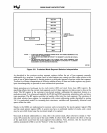
80286
BASE
ARCHITECTURE
The DF flag, like the
IF
flag,
is
controlled by instructions (CLD = clear, STD = set) or flag register
modification through the stack. Typically, routines that use string instructions
will
save the flags
on
the stack, modify DF
as
necessary via the instructions provided, and restore DF to its original state by
restoring the Flag register from the stack before returning. Access or control of the DF flag
is
not
inhibited by the protection mechanism
in
Protected Mode.
The Special Fields bits are only relevant in Protected Mode. Real Address Mode programs should treat
these bits as don't-care's, making
no
assumption about their status. Attempts to modify the
10PL
and
NT
fields are subject to protection checking in Protected Mode. In general, the application's program-
mer will not be able to and should not attempt to modify these bits. (See section
10.3, "Privileged and
Trusted Instructions" for more details.)
2.4
ADDRESSING
MODES
The information encoded
in
an 80286 instruction includes a specification of the operation to be
performed, the type of the operands to be manipulated, and the location of these operands.
If
an operand
is
located in memory, the instruction must also select, explicitly or implicitly, which of the currently
addressable segments contains the operand. This section covers the operand addressing mechanisms;
80286 operators are discussed in Chapter
3.
The
five
elements of a general
in~truction
are briefly described
below.
The exact format of 80286
instructions
is
specified
in
Appendix
B.
The opcode
is
present
in
all instructions; in fact, it
is
the only required element. Its principal
function
is
the specification of the operation performed by the instruction.
A register specifier.
The addressing mode specifier, when present,
is
used to specify the addressing mode of an operand
for referencing data or performing indirect calls or jumps.
The displacement, when present,
is
used to compute the effective address of an operand in memory.
The immediate operand, when present, directly specifies one operand of the instruction.
Of
the four elements, only one, the opcode,
is
always present. The other elements
mayor
may not be
present, depending
on
the particular operation involved and
on
the location and type of the operands.
2.4.1 Operands
Generally speaking, an instruction
is
an operation performed
on
zero, one, or
two
operands, which are
the data manipulated by the instruction. An operand can be located either
in
a register (AX, BX, ex,
ox,
SI, DI, SP, or BP
in
the case of 16-bii operands; AR, AL, BR, BL,
CR,
CL, DIl, or DL
in
the
case of 8-bit operands; the FLAG register for flag operations in the instruction itself (as an immediate
operand», or in memory or an
I/O
port. Immediate operands and operands in registers can be accessed
more rapidly than operands in memory since memory operands must be fetched from memory while
immediate and register operands are available in the processor.
An 80286 instruction can reference zero, one, or
two
operands. The three forms are as
follows:
Zero-operand instructions, such as RET, NOP, and HLT. Consult Appendix
B.
2-16


















